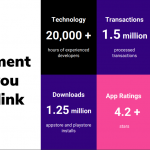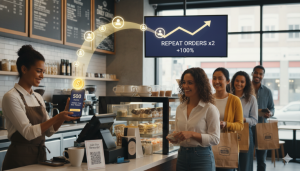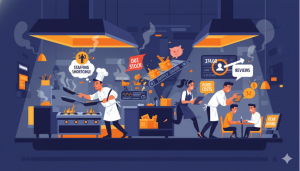Inventory management software is a great way to keep your restaurant organized and running smoothly.
Not only will it help you track the inventory of your food, drinks, and supplies, but it can also help you manage payments and billing procedures.
The digitization of the food and beverage industry called for an evolution in overall strategic & operational infrastructure for food businesses from all over.
All “thanks” to the recent Covid-19 pandemic, food brands made a rapid transition towards restaurant management software adoption, and online operations. It was a bold move. Many companies buckled under the weight of additional business responsibilities and had to through in the towel early.
Those that remained consistent, and worked in a smart way to integrate restaurant management software feature sets into regular online food ordering business operations, oversaw rapid scalability. At the moment, given that a food business owner has partnered up with the right aggregator, you are looking at an average increment in online food sales trend in tenfold.
This post highlights different aspects of restaurant management software, with extra emphasis on the best tools that are ideal for brand new food businesses on the get-go. We have kept pricing, features, and key technical aspects of such software tools in mind to help you make an informed decision at the end of the day.
Why Do Businesses Need Restaurant Management Apps?
There’s a reason why restaurant management apps are so popular.
These applications make it easy for busy managers to keep track of the daily operations of their restaurants, from ordering and stocking supplies to tracking customer stats and making reservations
Factors To Consider When Choosing Restaurant Management Apps
One important factor to consider when choosing an app for restaurant management is how it can help you automate tasks and processes in your kitchen.
Many apps offer features such as order tracking, dishwashing schedules, and inventory management. They can also help you manage finances, customer relations, and staff scheduling.
Another key factor to consider is whether or not the app offers GPS capabilities so that you can track the location of your restaurants in real-time.
Restaurant management apps that offer these feature are often more comprehensive than those that do not.
What is an Inventory Management Software?
An inventory management software is a computer program that helps businesses manage their inventories.
It can track and trace the whereabouts of all the products in a business, from production to sale, and make sure that everything is where it should be at any given time.
This software may also include features for tracking orders, keeping records of production dates and times, issuing sales receipts, and more.
Most inventory management platforms already have all these features. But, in case you need a custom application, you’ll need to put out an RFP for software development to find a suitable company
Inventory management software can help save money on storage costs by preventing excess stock from building up over time. And it can increase profits by helping businesses sell their product faster and at a higher price point than they would if they didn’t have an accurate inventory record.
Likewise, when we are looking at a broad-scale app for restaurant management, such as Blink Co., the feature set expands to the following variants. Essentially, they are all integral to business success, revenue management, and growth in the long run:
- Smart Inventory Management
- Food Order Menu Creation, Personalization, and Engineering Options
- Data-Driven Fleet Management Portal
- Robust POS Management
- Table Management System
- Food Costing Management
- Loyalty and Discount Campaign Management
In a way, the list could go on and on, but you get the idea.
Can I Use Any Restaurant Management Software for Food Business Scalability?
The answer is yes, and no, at the same time.
It actually depends on your business requirements. If you have a small-scale food startup, you are better off with a simple restaurant pos software, with inventory and fleet management features on the side. You will need to overlook your stock position and track your riders to evaluate average delays in food delivery and vice versa.
At the same time, if you have a food startup with an aggressive approach to near-future growth, you are better off with a food services partner that offers a combination of the aforementioned features. As much as the selection of such aggregators is important, it is imperative to know the pricing structure of such vendors.
GrubHub, UberEats, DoorDash are great choices for restaurants looking to expand. However, UberEats charges up north of 30% – 35% per order commission on each incoming food order. FoodPanda charges up to a 29% service fee on each incoming order and so on and so forth.
This type of payment model prevents enthusiastic food startups from scaling because they are oblivious to the aggregator monopoly. As a result, making profits is hard – whereas barely being able to reach the breakeven point is equally impossible.
The 3 Inventory Management Software For Restaurant In 2023
Take a look at some of the best restaurant management systems to date.
1. Blink Co. – Flexible Platform for Food Businesses:
Blink integrates multiple aspects of top-quality restaurant management software in a centralized manner. Partners only have to pay a nominal monthly subscription fee to access the full feature set. That way, Blink is more than an ideal choice for small food businesses that are looking to expand at their own pace.
At the same time, Blink Co. accommodates larger vendors by offering them the same premium features with a flexible payment that adapts to the business volume. For instance, a restaurant with 10 branches pays a comparatively low monthly service fee to Blink, as compared to other restaurants with 100 or more branches.
Some of the main highlights of Blink restaurant management software are appended below:
- White-labeled back and front end with tools specific to your restaurant’s operational agenda.
- Customized menu system to help create multiple menus within 5 – 10 minutes.
- Flexible payment options for your online restaurant customers.
- Marketing campaigns, discount deals, and other perks to kick your name-brand presence in no time.
- Customizable menu items.
- The dedicated mobile experience for your restaurant customers and food delivery agents.
- Exclusive insight on powerful marketing data, customer analytics, buying trends, and user reports for laser-sharp target-oriented results.
… and about a bazillion more perks that food businesses are known for reportedly enjoying with Blink Co.
Where to Sign Up?
Head over to our Blink for Restaurants page for more details on sign up process. You can also book your free demo with 24/7 customer support and technical insights on the overall sign-up process as a new food business owner.
[INSERT_ELEMENTOR id=”2061″]
2. Revel for Intuitive Restaurant Software Management:
Up next, we’ve got Revel for restaurants looking to use a cost-effective solution for day-to-day business operations.
Up next, we’ve got Revel software for restaurants. This one’s a perfect choice for high-volume online and real-life food businesses with complex requirements.
At a glimpse, the system offers the following features for you to begin with:
- Revel pos software offers nice visual menus, automated prompts, and the ability to modify items in the inventory management tab.
- Comes with a table reservation system for restaurants looking to accommodate dine-in customers.
- Contains add-ons, such as loyalty program support, online ordering, and vice versa. These features are available at an extra price though.
- Pos experience can be customized to meet food business owners’ requirements accordingly.
- Continue processing payments through a special “Always On” mode, even if the internet isn’t available for an intermittent period.
- Flexible payment options include credit/debit card payments, QR code payments, and ApplePay, etc.
Where to Sign Up?
You can log on to Revel Systems’ official website for more details. The base version of the software comes with a 3-year contract and a $99 monthly fee.
3. Lightspeed:
Lightspeed is a combination of inventory management, Pos solutions, table reservation management and such other variants for online/ real life food order businesses. It might not be a fully-fledged restaurant management software, but it is close enough to Blink Co. and other top-level vendors.
The only setback to using Lightspeed software is that they have an iPad POS system. Therefore, if your restaurant customers are using Apple devices, you can’t force them to switch to Android smartphones to make payments.
However, Lightspeed restaurant does have plenty of features to make up for the Android side of things.
- Cost starts at $69 per month (*billed annually). Makes it a feasible solution for food startups.
- Order takers can send order data to the kitchen directly from bus tables.
- Can be integrated into live Kiosks with self-ordering systems.
- Incentivize employee bonus system by rewarding key performing employees during restaurant rush hours.
- Integrate with QuickBooks, KDS *(Kitchen Display System), and customer-facing digital displays for a delightful experience.
Where to Sign Up?
Log on to Lightspeed Restaurant’s official website for additional details.
In addition to the above features, Lightspeed pos software for food businesses charges an additional 2.6% + $0.10 against each transaction based on swiped, tapped, or dipped modes. This is a low payment percentage as opposed to high-end pos vendors.
[INSERT_ELEMENTOR id=”2061″]
Conclusion:
For any thriving restaurant business, success isn’t entirely dependent on choosing the right restaurant management software. On the contrary, it is a combination of data-driven metrics, smart use of customer analytics data, and of course the base feature sets.
Although a software solution might make it easier for you to manage your restaurant operations, you will need to imply a proper strategy for growth. To that effect, feel free to go through the rest of Blink’s Blog Roll to get an exclusive scoop on the latest trends in the F&B industry, SEO strategies for restaurants, and food order menu engineering tactics.
Good luck!
Related Articles:
 Our Guide to the Best Restaurant Management Software & What to Consider
Our Guide to the Best Restaurant Management Software & What to Consider
 HOW TO START A RESTAURANT BUSINESS WITH NO MONEY
HOW TO START A RESTAURANT BUSINESS WITH NO MONEY
 6 Restaurant Opening Promotion Ideas to Win More Customers
6 Restaurant Opening Promotion Ideas to Win More Customers
 How to Open a Restaurant in Dubai or UAE (Updated 2023 Guide)
How to Open a Restaurant in Dubai or UAE (Updated 2023 Guide)
 5 Best Restaurant Promotions that Work for BlinkCo.’s Clients
5 Best Restaurant Promotions that Work for BlinkCo.’s Clients








